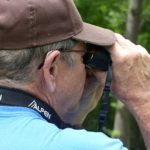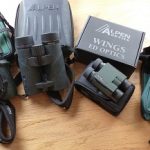Can you introduce kids to bird watching and get “outside” during novel coronavirus times?
We read a short article written by a diehard baseball fan. She had bought season tickets to her beloved St. Louis Cardinals just before the pandemic hit. When the virus shut down baseball she said, “I’m not watching the Cardinals but I am loving the cardinals……the ones that sing in my backyard.”
Like the baseball fan, many people are enjoying birds in their yards and neighborhoods – often for the first time. Birding is an outstanding hobby and this spring is an outstanding time to start. Being confined to the house and yard is a great opportunity to introduce kids to birds. Also, usually, the best birding of the year is in early May when avian migrants move through and visitors from the far south nest nearby.
Birding requires no license. There isn’t a closed season. Enjoying birds is free and can be done everywhere, even in the biggest cities. It’s a hobby that can be started simply and may evolve into a lifelong passion.
Basic Homebound Birding with Kids

Bird watching is again a joy with hearing aids.
Cost: nothing.
Special equipment needed: None, but a pencil and a few sheets of scrap paper can help record observations.
Encourage kids to watch birds in the yard. Most can identify cardinals, blue jays, and house sparrows but distinguishing species for a beginner isn’t essential. Just have kids note how one type of bird looks and acts differently than others. Essentially how a cardinal differs from a sparrow. Maybe have the kids sketch the birds they see.
The Next Step
Cost: Around $125 for entry-level binoculars and a basic bird book.
Equipment: Binoculars and a bird book and bird apps:
At this stage begin identifying and recording species seen. Read with a child descriptions of the life history, migration patterns, and habitat of different species.
List all the birds seen in the yard. This is the start of a “life list”.
A Little More Advanced
Cost: Not much. The basic equipment listed above works but add in a few dollars for gas to visit nearby habitats.
After a child can distinguish between backyard bird species and has used a bird book or app it’s time to search for more species. Bring along binoculars and a pad and pencil. Visit nearby wetlands, woodlands, and grasslands. Even with novel coronavirus shutdowns, most places allow people to visit parks and natural areas. Each will feature new bird species. Take note of them and read about each. Add new species to the list started with backyard birds.
Igniting a Passion
Most children are curious about nature and seeing just one or two fascinating birds can ignite a lifelong passion that may become a delightful hobby or even a professional career. Advanced birders purchase sophisticated optics and travel the world to see new species and learn more about these fascinating animals. Hopefully, the novel coronavirus will pass soon and the world opens to a youngster with a new birding hobby. It all can start by spotting a blue jay in the backyard.
Where to Get Information
At Winding Pathways, we have many paper bird books produced by several companies. We don’t favor one over the other but often refer to several when we’re trying to identify a bird new to us. Increasingly we rely on the Merlin App created by the Cornell Laboratory of Ornithology. The descriptions of hundreds of bird species, along with photos and calls, is at the tip of our fingers on our iPhones. It’s free. Simply go to the App Store and search for Merlin. The Lab of Ornithology has many other fascinating resources that can be accessed from a computer or smartphone, and we love their paper magazine Living Bird.
The National Audubon Society is highly bird-oriented and has local chapters. Attending a meeting or going on a birding excursion with members is an outstanding way to connect with people who share a bird passion. Some chapters may offer ZOOM meetings. Others hold online excursions to help people get and stay connected. Earth Day saw a host of events online.
We also enjoy reading Bird Watcher’s Digest, a small format magazine that features articles about individual species and places to enjoy them in every issue. The Internet is loaded with many other bird resources.
Optics

Alpen optics are good quality with good value.
We are often asked what type of binoculars we use. None of our optics is high end. Rich prefers 8X42 power while Marion’s are 10X42. The first number is the magnification and the second indicates how much light enters the optic. Eight or 10 powered binoculars that give a clear view and fit well in someone’s hands are ideal for a budding birder. Tiny micro binoculars are great for travel but we find them much harder to use than larger ones.
Spring is the best time to see migrating birds, and the novel coronavirus is confining people to yards. It’s an opportunity to take notice of the colorful and interesting wildlife that comes to us. This is a wonderful time for a child to launch a birding hobby.


I loved your article to introduce children to birding. Some things that I particularly note are the color of the beak and feet. Does the eye have a ring around it. Does a bird have wing bars or that red shoulder patch like the Red-winged Black Bird.
We’ve seen some migrants coming through like the gorgeous Red Breasted Grosbeck or the Indigo Bunting. Spring is an exciting time to see all sorts of birds. Oh, did I mention the Eastern Towhee and the Thrush?
Blessings, Jac